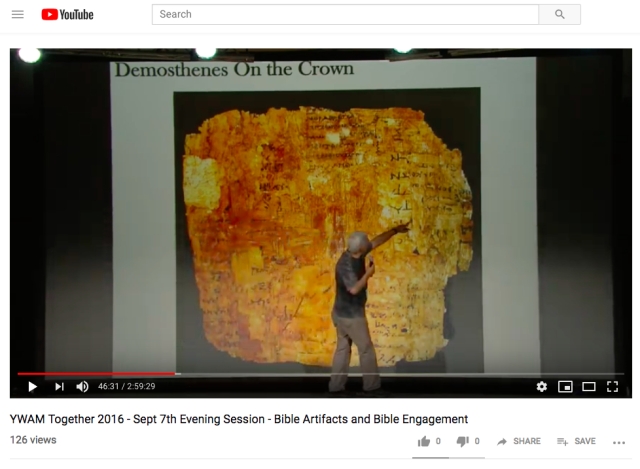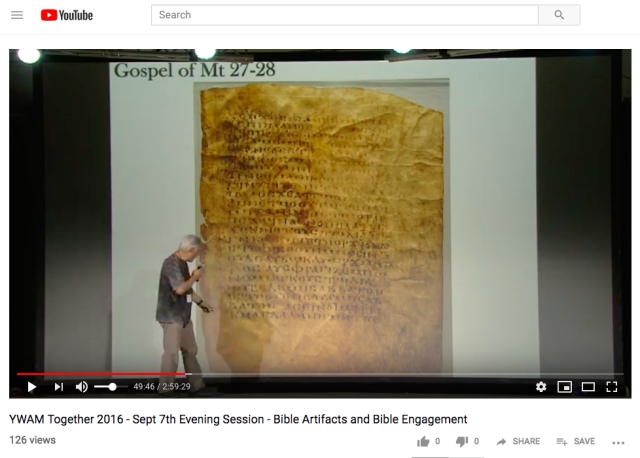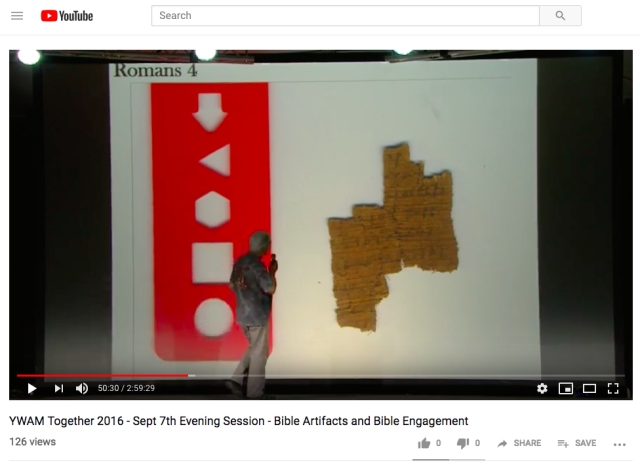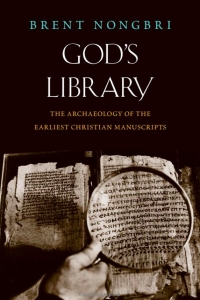
Thanks again to the resourcefulness of David Bradnick, here is still another video of Scott Carroll displaying still more papyrus and parchment manuscripts, including some Greek and Coptic manuscripts that have not appeared in the other videos I have surveyed. This video was filmed in Kansas City on 7 September 2016 during a meeting of the group Youth With a Mission.
Scott Carroll’s portion of what seems to have been a quite long evening begins at about the 32:50 mark and is notable for the number of Coptic manuscripts included in the presentation. Around the 38 minute Mark, Carroll gives an overall description of the material he will discuss: “recently discovered. . .all new material. . .some of these things are as recent as this past week.” One of Carroll’s slides describes this material as “Buried Treasures”:

Carroll begins by showing a series of slides from the dismantling of the mummy mask at Baylor in 2012. [Update 29 January 2019: Upon further review, I’m pretty sure these slides show a mask that is different from the one dismantled in 2012, but the sink in the images looks like the same one; so it appears there was another mask dismantling that took place at Baylor at some point.]

After this series of slides, Carroll comments (at 42:10):
“Out of that particular mask, um, hundreds of texts came out, and they all pieced together into one partial scroll. Now, sometimes we actually have had the blessing and opportunity to have discovered scripture in this context.”
From that point, Carroll moves on to several slides of classical and Christian manuscripts. Many of these we have seen before in Carroll’s other videos, but some of them are new (to me, at least). So, once again, I’ll provide the images Carroll displays with his identifications below (time markers for the screen shots are at the bottom of the images).

A papyrus fragment containing the beginning of the Iliad. At this point Carroll also mentions another papyrus of the Iliad as well as a fragment of Aesop’s fables and fragments of the Iliad and “an early Church Father of importance”

A clump of “cartonnage” of some sort, apparently (according to the label on the slide) containing Demosthenes, On the Crown.

Genesis 11 (left); Genesis 17 (right).

Parchment fragment of 2 Kings in Coptic.

Our old friend, the papyrus clump containing 1 Samuel in Greek (along with, apparently, portions of the Iliad).

According to Carroll, “the earliest text of Psalm 4 and 5” (left); parchment leaf containing Psalm 49 and 50 in Coptic (right).

A papyrus fragment containing Isaiah 65 (left) and what looks like an Aramaic incantation bowl (right).

Two papyrus fragments of Matthew (Matthew 6 on the left, Matthew 12 on the right), both, according to the slide label, allegedly dated to the second century. According to Carroll, “These are all things we’ve worked on in the last couple years.”

A parchment fragment in Coptic. According to Carroll: “This is the earliest text in the world of the, um, of Jesus, the holy family being exp–Herod’s attempt to, uh, kill them, and they’re going to Egypt.”

Two papyrus fragments of Luke.

Gospel According to Matthew on parchment.

A fragment of Acts in Coptic on parchment.

Carroll: “I got this, uh, two weeks ago. It’s the earliest known text of Romans chapter 4.” In another video, Carroll had identified this fragment as “a very early text of John.”

A papyrus fragment containing Romans 9-10. More of this leaf was shown in Carroll’s slides in a 2018 video.

A fragment of a papyrus leaf containing Romans 14 in Coptic.

A papyrus fragment containing 1 Corinthians. More of this leaf was shown in Carroll’s slides in a 2018 video.

“Twenty pages from 1 Corinthians” as well as parts of 2 Corinthians and Galatians from the same manuscript.

Carroll: “This is from two weeks ago. This is one of the earliest accounts in the world of 2 Corinthians. . . This was part of a bookbinding.”

Fragment of a papyrus leaf of Galatians 3-5.

Fragment of a papyrus bifolium containing Ephesians.

Fragments of papyri of Hebrews 9 (left) and Hebrews 11 (right).
 What appear to be documentary papyri that Carroll describes simply as “other texts.”
What appear to be documentary papyri that Carroll describes simply as “other texts.”

And finally, an item that Carroll describes as “the earliest known, uh, text of Esther. This was two weeks ago.”
So, again, the same questions arise: Which of these manuscripts belong to the Green Collection / Museum of the Bible, and which of them belong to Carroll? And of course, from whom were the manuscripts bought?


Reblogged this on Talmidimblogging.
Didn’t Roberta Mazza debunk the whole mummy mask claim?
Yes, Roberta Mazza pointed out some time ago that it would be highly unlikely for any Christian texts to be extracted from mummy masks, since the practice of using inscribed papyri for constructing masks seems to have died out after the age of Augustus. But Carroll continued (and continues) to make the claim. It remains to be seen he has any actual evidence to back it up. There is no doubt, however, that the Green Collection bought and displayed several mummy masks and that Scott Carroll has dismantled at least one.
Another option–though I do not claim that it is likely–is that some mummy masks aren’t as old as claimed. After all, who owned a railway car full? Maybe tourist shop items, even if made with older papyrus?
More speculation, perhaps more likely this time: genuinely ancient mummy mask cartonnage is more likely to be from rolls than from codices, and the rolls are more likely than not to be written on both sides, hence not easily reusable for writing.
Further, if I may rephrase a comment on AnneMarie Luijendijk’s interesting contribution to Oxyrhynchus trashology, which I hope she will address in her forthcoming book: though it may well be that some highly-informed Christians ritually desacralized retired old books, other books (torn whenever) were probably trashed by illiterates.
Hi, Brent, just two notes:
“A parchment fragment in Coptic. According to Carroll: “This is the earliest text in the world of the, um, of Jesus, the holy family being exp–Herod’s attempt to, uh, kill them, and they’re going to Egypt.” — this Sahidic fragment was displayed in the exhibition “Belarus and the Bible,” which took place last year in Minsk. Scott Carroll was there. According to description, the fragment would now be in the Museum of Christian Missions in South Korea. See the photo here: https://www.nlb.by/en/news/National-Library-of-Belarus/belarus-and-the-bible-a-unique-exhibition-runs-at-the-national-library-of-belarus/
I’ve seen this fragment before, while it belonged to another owner, together with the Sahidic parchment fragments of 2 Kings and Acts which you have shown above.
“Fragment of a papyrus bifolium containing Ephesians.” — the photo is quite bad, but I am 99 % sure this is a fragment of the famous Tchacos codex of the Pauline epistles.
Alin, I have noted that also an Illiad papyrus was displayed in that exhibition in Belarus, which was said to belong to the same museum in South Korea.
Does anyone know anything about this museum in South Korea? I came up empty with a quick search.
I also tried googling some combinations and didn’t find anything.
Pingback: More of Scott Carroll’s Papyri? | Variant Readings
Museum website is http://museum-kcm.or.kr .
Thanks–so, the English name seems to be “Korea Christian Mission Museum.”
Maybe (?) this is about that museum:
http://www.kukmindaily.co.kr/article/view.asp?arcid=0011373358
PCK Hapdong Opens Christian History Museum
2017-04-03 17:03
Pingback: Sources and Destinations of Scott Carroll’s Papyri? | Variant Readings
Pingback: The Green Collection Mummy Masks: A Possible Source | Variant Readings
Pingback: The Tchacos-Ferrini Codex of the Pauline Epistles in Coptic | Variant Readings
Pingback: Another Part of Scott Carroll’s Manuscript Network | Variant Readings
Pingback: Recently Emerged Papyri of Dubious Origins: A Working List | Variant Readings
Pingback: A Couple More Manuscripts of Questionable Origins | Variant Readings
Pingback: Recently Emerged Coptic Manuscripts of Dubious Origins: A Working List | Variant Readings